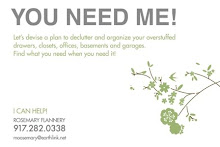
It’s A Taxing Time
Tax Day is quickly approaching so you may be scrambling to assemble all the pertinent paperwork to prepare your tax forms. I’m even a little late myself this year having had my appointment earlier this week.
As you’re compiling the back up for your return, you are probably uncovering a pile of papers from bank statements, utility bills to a bill from an item you no longer own. Is it ok to dispose of these outdated docs or are they necessary to keep? Many financial advisors have varying opinions on this topic. Here is what Suze Orman in her March 2010, “O Magazine” column recommends:
Utility Bills: Hold on to these for one year—just in case there are any billing issues. If you claim a
home-office deduction, keep statements for three years because that's how long the IRS generally has to
challenge tax returns.
Pay Stubs: Save one year's worth. Once you receive a year-end W-2 statement, check it against the last
pay stub. If it all matches, chuck the backup.
Bank and Credit Card Statements: Keep for one year, but with this caveat—if you expect to apply for a
mortgage, HELOC, or car loan in the near future, hoard two years' worth of bank statements. After being
burned by their own no-doc policies prior to the credit crisis, many lenders are now asking for a ton of
income verification before granting any loans, especially for the self-employed. If you bank and pay your
bills online, you can typically access at least six months of statements at no charge. Save pdfs of them on
your hard drive (or print out copies) in case you need the information; you may be slapped with a fee if
you have to ask your bank or credit card company to cough them up later.
Investment Statements
You probably receive monthly or quarterly updates, as well as an annual summary. Once you get that
annual statement, toss the others.
If you make any trades during the year, keep a record of each transaction for at least three years.
For nondeductible contributions to a traditional IRA or conversions to a Roth IRA, save the IRS form 8606
you filed when making the deposits. When you withdraw during retirement, it will be a piece of cake to
prove you've already paid the taxes.
Tax Returns and Supporting Docs
Since the IRS has three years to challenge anything, you must keep three years' worth of returns and
Warranties and User Manuals
Save active warranties; equally important is letting go of expired ones.
Although the 100-page tomes covering operating details of shiny new gadgets are not financial
documents, I've included them here because they go hand-in-hand with warranties and contribute to so
much clutter. If you find yourself staring at a user manual for the cell phone you lost in a cab last month,
trash it right now! And if you're comfortable Web surfing, get rid of all user manuals: Manufacturers have
downloadable versions on their Web sites, and plenty of third-party sites amalgamate manuals from
different companies (try UsersManualGuide.com and ManualNGuide.com).
Forever Docs
Some stuff should never, ever be tossed: birth certificate, marriage license, divorce decree, will, trust,
estate planning documents, and death certificates. Make sure your family can access these important
records if you die.
I'd also suggest keeping a permanent file of all loans you have paid off (mortgage, car, school, and so on)
because if you later find a mistake with how the data was reported to credit bureaus—or if an identity thief
complicates your life—having those docs handy will save you much grief.
Keep It or Not?
Get Rid Of… ATM slips more than a month old. Toss them after checking them against your monthly statement.
Be Sure to Save… Receipts for big-ticket purchases that might be included in an insurance claim. And
photograph the possessions; the more documentation you have, the easier the claims process will be.
My accountant gave me a list too so see which one works for you.
Now that we’ve covered what to keep, the next step is where to store these papers for future access. Since I live in a studio apartment and don’t have room for file cabinets, I use expanding A-Z letter-size accordion folders. I even treated myself to new ones at the beginning of this year from the Container Store. I am a little general in my filing system – everyone has their own method – e.g., Con Edison bills go under “C” rather than “E’ for electricity or “U” for utilities.
If you itemize your return like I do and need to hold onto receipts, I use the A-Z accordion system checkbook version. I label each section with the appropriate categories, i.e., transportation, magazines, business meals, etc. You can label it any way that works for you. Every time I have a new receipt, I mark it and store it in my file. I try to deal with receipts immediately so there is no pile-up or risk of losing them. At the end of the year, I spend an afternoon totaling up my receipts in preparation for my tax return. If you prefer, not to handle/store receipts, scanning is an option for digital storage. You can also use Quicken Software to enter receipts and it will calculate your totals for you.
Whatever method you choose, I hope your tax prep is not too painful and that you use your refund to obtain some tools to make your life simpler. And don’t forget to shred, shred, shred and recycle that paper!
2010 Rosemary Flannery All Rights Reserved


